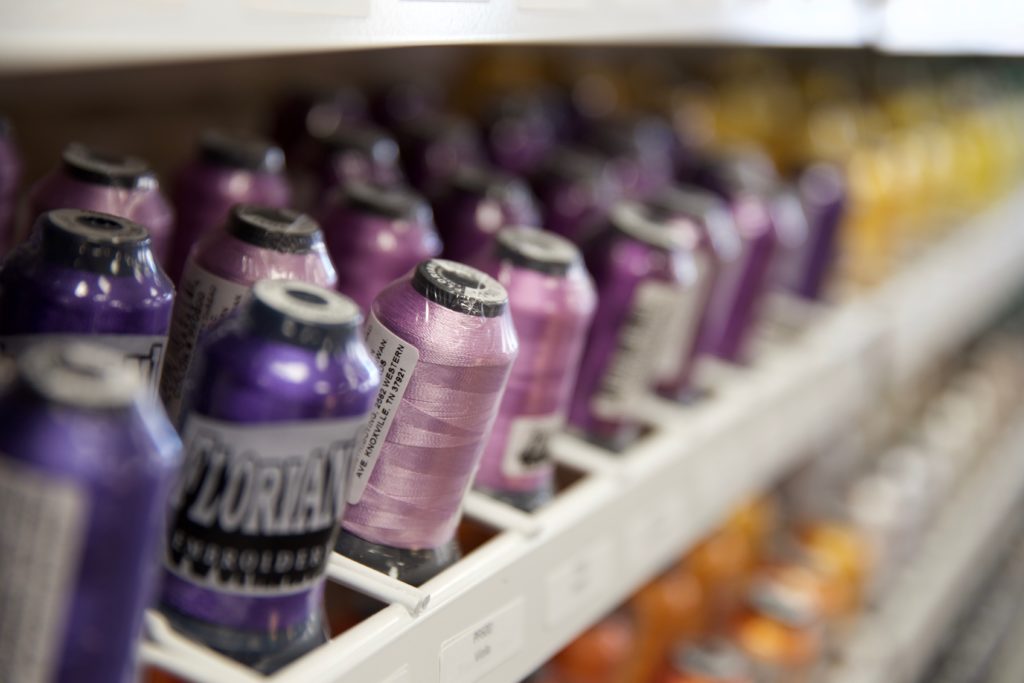11 Random Thoughts on Thread

I have a friend who calls me a thread snob. Maybe so. I do have pretty strong opinions on thread when I sew. So I put together a list of 11 random thoughts on thread. Pretty much just a list of things that have come to mind lately that could be helpful for anyone who’s had thread issues in the past, or looking to prevent them in the future.
- When quilting, I like a cotton thread with a long staple. What’s a staple you ask? The staple is the fiber that makes up the ply’s in the thread, the longer the better.
- I prefer a premium thread. I’ve found that Mettler makes a cotton thread that’s really nice. It’s 50 weight, with a silk finish, meaning less fuzz. Cotton thread always produces fuzz or lint. Auroral and King Tut are also great threads, but are much pricier.
- When sewing other things, I like to use a premium poly thread. Madiera Aerofil (not to be confused with Aurofil) or Gutterman are good threads. Madiera aerofil comes in LOADS of colors, so you can generally always find what you’re looking for.
- Embroidery thread is usually a 40 weight, balanced with a 60 weight bobbin thread. However, if you’re using a 60 weight on top, be sure to use a 90 weight on the bobbin.
- I prefer Madiera and Floriani over other brands. They both have a wide color selection as well as running through the machines easily.
- Hands down, Floriani makes the best metallic threads. You can run them at high speed, with no Sewers Aid (thread lube) needed.
- Try new things. There are so many fun and decorative threads out there for crouching or using in serger loopers. Just have fun with it, be creative, and think outside the box a little.
- I don’t really recommend using the thick commercial nylon threads in a household machine. They are too thick for the bobbin and upper tension units. There are tricks and ways to pull it off if it’s really necessary, but be sure to come ask us for help first!
- Sometimes we go to fabric stores and their thread displays are not clearly labeled for thread types. Mixed in there can be threads for hand work. Those threads are often waxed and therefore should not be used in a machine, it will gum up your tension discs. Even the upholstery thread can be too thick for your bobbin case. You could balance it with a good polyester in the bobbin case, or we can tension a new bobbin case for you that can handle those thicker threads.
- As a rule, I try hard to store thread in an airtight container. Thread has about a 5 year shelf life when left out in the air. I often see people bring in machines with Grandma’s wooden spool still on the machine. I pull it off and explain that thread that old should be a decoration in their sewing room. Tinsel strength leaves thread as it gets old. There’s a way to test your thread to see if it’s too old. Pinch a length of thread between your thumbs and index fingers. Wrap it around to your pinky fingers and try to break it. If it snaps and breaks almost immediately then throw it out, or use it for hand basting. If it hurts a bit against your pinky and doesn’t break immediately, then it’s probably ok to use.
- I feel like if I’m buying nice quality fabric, why would I make something using inferior quality thread? Be sure to get a thread that won’t break so easily, and your project will last longer and be more durable. Here’s a good rule of thumb: If the thread is sold in a bin for a low price, best to stay away from it. These can leave a lot of lint, or break easily. We try to blame our machines for this, but sometimes we need to blame the thread.
Marlene Watts
Missouri Sewing Machine Company (North Store)